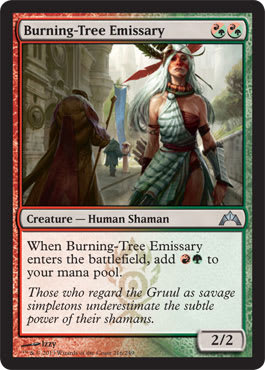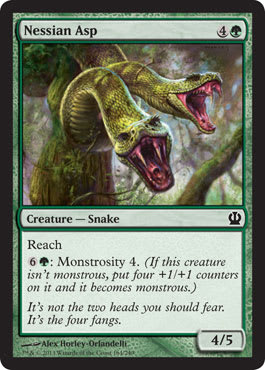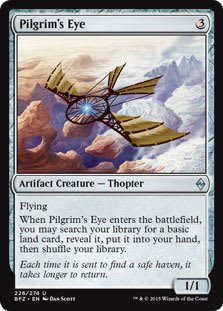Last week was a wild ride for Pauper. Monday saw Modern Masters 2017 confirmed as legal come Wednesday. Tuesday saw an announcement that due to an issue, the 22 new commons as well as the Treasure Chest cards from Conspiracy: Take the Crown would not be coming to the format until April 19th. There was plenty of outcry, including my own take, but by the end of the evening I was content to have this article express my opinions on Pauper’s place in the Magic Online ecosystem and the issues facing the format. Then Wednesday came and another announcement dropped — this one that the folks at Wizards worked to deliver on their original promise. So we are right back where we started — with Modern Masters 2017 and the Monarch mechanic making an impact.
The short version of my thoughts can be summed up as: it stinks that they had to work through the night just to deliver on the original deadline.
With that behind us the new cards are here and the look of Pauper is starting to change. The early returns have Burning-Tree Emissary Stompy as the new baseline of the format. Part of this is the normal period of adjusting to new threats. I am also sure that part of this has to deal with people taking their time before investing in new cards.
Going into the Modern Masters 2017 era I picked up a deck that I had some success with in the previous weeks. It fell in line with my desire to find a deck that could consistently go 3-2 and 4-1 rather than spike 5-0s. That deck is Bant Control.
Grixis Control ? Kaladesh Standard | Shota Yasooka, Winner Pro Tour Kaladesh
- Creatures (6)
- 2 Torrential Gearhulk
- 4 Thing in the Ice
- Planeswalkers (1)
- 1 Jace, Unraveler of Secrets
- Instants (21)
- 1 Ceremonious Rejection
- 1 Essence Extraction
- 2 Glimmer of Genius
- 2 Negate
- 2 Unlicensed Disintegration
- 3 Anticipate
- 3 Harnessed Lightning
- 3 Void Shatter
- 4 Galvanic Bombardment
- Sorceries (6)
- 1 Transgress the Mind
- 2 Radiant Flames
- 3 Painful Truths
- Lands (26)
- 2 Mountain
- 2 Swamp
- 5 Island
- 2 Wandering Fumarole
- 3 Smoldering Marsh
- 4 Evolving Wilds
- 4 Spirebluff Canal
- 4 Sunken Hollow
- Sideboard (15)
- 1 Negate
- 1 Radiant Flames
- 1 Jace, Unraveler of Secrets
- 1 Transgress the Mind
- 2 Ceremonious Rejection
- 2 To the Slaughter
- 2 Confiscation Coup
- 2 Summary Dismissal
- 3 Weaver of Lightning
Jeskai Control ? Kaladesh Standard | Carlos Romao, Finalist Pro Tour Kaladesh
- Creatures (5)
- 2 Archangel Avacyn
- 3 Torrential Gearhulk
- Planeswalkers (2)
- 2 Dovin Baan
- Instants (20)
- 1 Blessed Alliance
- 2 Summary Dismissal
- 3 Anticipate
- 3 Immolating Glare
- 3 Void Shatter
- 4 Glimmer of Genius
- 4 Harnessed Lightning
- Sorceries (5)
- 2 Fumigate
- 3 Radiant Flames
- Enchantments (2)
- 1 Quarantine Field
- 1 Stasis Snare
- Lands (26)
- 4 Island
- 6 Plains
- 1 Spirebluff Canal
- 3 Inspiring Vantage
- 4 Aether Hub
- 4 Port Town
- 4 Wandering Fumarole
- Sideboard (15)
- 1 Fumigate
- 1 Blessed Alliance
- 1 Linvala, the Preserver
- 3 Negate
- 3 Spell Queller
- 3 Gideon, Ally of Zendikar
- 3 Ceremonious Rejection
The story of this deck begins with Pro Tour Kaladesh. Specifically the finals of that tournament. I became enamored with the idea of a spell based control deck in Pauper. Considering that the format has access to three slow Snapcaster Mage slow cards — Archaeomancer, Izzet Chronarch, and Mnemonic Wall, I was firm in my belief that such a deck could be found. Sure, these cards would never actually cast their targeted spell but given a cheap enough option simply getting it back was close enough.
So why did I feel compelled to build a spell based control deck? At the time creature strategies were dominating Pauper. Because of this I felt that a spell based strategy could find success. Now I was not going to be completely without creatures since a core principle of the idea was to be able to reuse powerful spells with Archaeomancer and the like. I was also interested to see how far I could push cards with Awaken as reasonable inclusions and potential win conditions. While there are not many commons with the Battle for Zendikar mechanic there was one that I have had my eye on for some time in Sheer Drop.
Sheer Drop is about as close to Shriekmaw as it gets in Pauper. As a ![]()
![]() sorcery that destroys a tapped creature it is a bit behind the curve while a 3/3 for
sorcery that destroys a tapped creature it is a bit behind the curve while a 3/3 for ![]()
![]() that does the same is also a bit too slow. Together, however, there is enough flexibility to warrant examination. Pauper has cards like Steamcore Weird, Ghitu Slinger, and Silumgar Butcher to handle smaller creatures. The format also has Faceless Butcher, Predatory Nightstalker, and Heartstabber Mosquito. These all have different downsides with the Butcher being vulnerable to removal, the Nightstalker is not guaranteed to hit the intended target, and the Mosquito is even more expensive than Sheer Drop. Sheer Drop has access to two modes and while both are just a little more than I’d like to pay combined they form a serviceable card.
that does the same is also a bit too slow. Together, however, there is enough flexibility to warrant examination. Pauper has cards like Steamcore Weird, Ghitu Slinger, and Silumgar Butcher to handle smaller creatures. The format also has Faceless Butcher, Predatory Nightstalker, and Heartstabber Mosquito. These all have different downsides with the Butcher being vulnerable to removal, the Nightstalker is not guaranteed to hit the intended target, and the Mosquito is even more expensive than Sheer Drop. Sheer Drop has access to two modes and while both are just a little more than I’d like to pay combined they form a serviceable card.
Testing Sheer Drop saw it over perform. While it was tough to use against the quicker decks in the format the ability to shut down the mid-game creatures was a huge bonus. Additionally the potential to get it back and leave behind a reasonable creature was valuable. Often Sheer Drop became the last spell I cast to lessen the chance of losing a land to Lightning Bolt. Ideally I would run one and a half copies of the card but since that isn’t possible I settled on one.
Running cards like Archaeomancer and Sheer Drop meant that this deck was set up to try and go long. Originally this meant running some number of main deck Fog effects. Here is where the third color came into play. Green provided Moment's Peace and Pulse of Murasa which let the deck survive into the late game and let the value of Mancer take over. Pulse also makes Mulldrifter better and since this is a Blue deck there definitely were going to be Mulldrifters. Green also provided another way for the deck to win the long game in Battlefield Scrounger. Scrounger is not only a sold threat that often demands two removal spells but it can also stack the deck late. Once the game reaches an end stage and the library has been depleted Battlefield Scrounger can start adding key cards back to the deck. Normally this would include Sheer Drop and other defensive spells to help keep the board clear.
Here is the deck I ended up running leading up to the release of Modern Masters 2017:
Bant Control ? Pauper | Alex Ullman
- Creatures (12)
- 1 Battlefield Scrounger
- 1 Monastery Loremaster
- 1 Nessian Asp
- 1 Pilgrim's Eye
- 2 Archaeomancer
- 3 Mulldrifter
- 3 Sea Gate Oracle
- Instants (16)
- 1 Capsize
- 1 Dramatic Rescue
- 1 Oona's Grace
- 1 Repeal
- 2 Condescend
- 2 Counterspell
- 2 Echoing Truth
- 2 Piracy Charm
- 2 Prohibit
- 2 Pulse of Murasa
- Sorceries (5)
- 1 Sheer Drop
- 4 Ponder
- Enchantments (4)
- 1 Oblivion Ring
- 3 Journey to Nowhere
- Lands (23)
- 3 Forest
- 3 Plains
- 7 Island
- 1 Azorius Chancery
- 1 Blossoming Sands
- 1 Kabira Crossroads
- 1 Simic Growth Chamber
- 1 Thornwood Falls
- 2 Ash Barrens
- 3 Tranquil Cove
- Sideboard (15)
- 1 Oblivion Ring
- 1 Pulse of Murasa
- 1 Serrated Arrows
- 2 Dispel
- 2 Divine Offering
- 2 Holy Light
- 3 Hydroblast
- 3 Standard Bearer
A few notes on some card choices.
Dramatic Rescue is far from a staple but it does quite a bit in this deck. Not only does it allow for everlasting chump blocks with Archaeomancer. The two life is far from negligible in a format as a aggressive as Pauper. The two colors in the mana cost makes it hard to run multiples of the card but a single copy has been better than anticipated.
Monastery Loremaster is a slow Archaeomancer with the upside of being able to get back cards like Journey to Nowhere. When turned face up as a Megamorph the Loremaster also has the ability to close out games, something this deck needs.
Nessian Asp is has keyword big. It gets around Flame Slash and does the business as a wall against creatures with flying. Once it gets Monstrous it can end the game in three swings by itself or two with the help of a Mulldrifter. Nessian Asp is never going to be the best card in your deck but it does fill its role nicely.
Pilgrim's Eye was a concession to the three color nature of the build. Sea Gate Oracle is a great 3-drop but sometimes you just need to draw the right land. Pilgrim's Eye allowed me to do that as long as I had 3 mana available. It then turned itself into a chump blocker and saved some life points as well.
Bant Control was a fun option, but during the course of playing it I started to ask myself why I was not using an UrzaTron mana base. UrzaTron provides the mana needed to accelerate this deck from the developing stage to one of abundance. The problem with Tron is the number of slots taken up by additional cards needed to facilitate simple spellcasting. Prophetic Prism, Prismatic Lens, and Shimmering Grotto are all fine but they take up slots that could be spent on action in the case of the Artifacts. People also are fond of sideboarding in land destruction against Tron decks and while they did the same to Bant losing a Forest hurts far less than losing an Urza's Tower.
This version of Bant taught me it is possible to play in the fringes of the format. If the goal is to win consistently and not to go undefeated every time there is a lot of space available to explore in Pauper. Bant is not likely to become a top tier deck any time soon but it does have some advantages. It is flexible in its configuration and has access to more potential spell slots than Tron decks. I was excited to try and update the deck with Augur of Bolas and give it a whirl.
Except the deck faltered. Augur of Bolas was a fantastic card and while it made some demands of the deck — including Sunlance, for example, it was a fantastic play on turn two, three, or even later. The problem with Augur of Bolas is that it forces you to move past your best card in Mulldrifter. I am not trying to say that Augur of Bolas is better or worse than Mulldrifter, just that they demand completely different decks. If I were to continue along the line of Bant I think it would have to be a Mulldrifter deck, not an Augur of Bolas deck. Mulldrifter and Pulse of Murasa is strong but the ability to retain access to Journey to Nowhere is also important.
Augur of Bolas did work very nicely with Sunlance. In something that should surprise no one the Augur pairs well with cheap removal. Augur of Bolas on the second turn is fine but being able to cast Augur on turn two and follow it up with another spell is massive. As Burning-Tree Emissary gains in popularity the ability to block a 2/2 while also taking out another creature becomes increasingly important. Augur of Bolas is a fine card for these decks but currently Bant is not a good home.
I did a lot of losing with Bant. I also did plenty of winning, but the losses were more valuable in teaching me about the upcoming state of Pauper. Blocking is going to be important and incidental life gain can help keep you alive. Augur of Bolas is a great card but it has problems in the same deck as Mulldrifter. I also learned it is possible to play a long game deck without UrzaTron. Finally, I learned that if you’re willing to be happy with coming out a game or two ahead it is possible to find new and interesting decks to play in Pauper.































